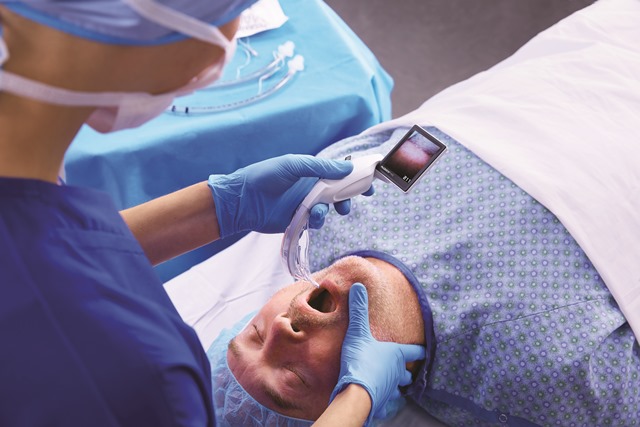
Stories
COVID-19 highlights value of video laryngoscopy
By Patrick Nellis and Eliana Landori Reducing risk In emergency departments and intensive care units across the country COVID-19 has changed the way hospitals operate. With an increased need to...

By Patrick Nellis and Eliana Landori
Reducing risk
In emergency departments and intensive care units across the country COVID-19 has changed the way hospitals operate. With an increased need to support patients in respiratory distress, a new focus is being placed on video laryngoscopy (VL) for intubating patients being put on a ventilator.
VL has won growing acceptance because the enhanced visualization makes it more likely intubation will be successful on the first try, making the process safer for physicians and patients compared to traditional direct laryngoscopy (DL). Additionally, VL reduces the risk of spreading a highly contagious virus.
“The availability of a video laryngoscope at every intubation minimizes errors and unforeseen difficulties, enhances feedback, learning and teaching,” says Marco Zaccagnini, Registered Respiratory Therapists/Certified Clinical Anesthesia Assistant. “It shares the intubation with the medical team and provides a safer environment for both the operators and patients.”
Traditional intubation
Endotracheal intubation involves inserting a plastic endotracheal tube through the mouth or nose, through the larynx (which includes the vocal cords), and finally into the trachea (windpipe). The tube is guided into place with a device known as a laryngoscope, before being attached to a ventilator.
In a conventional DL intubation, the physician can see the tip of the laryngoscope as it enters the mouth, but must then rely on “feel” and experience to make sure it avoids the esophagus and is positioned correctly. Direct laryngoscopy can be difficult with some patients. Obtaining a view of the larynx is key to this technique and can be influenced by factors such as the structure and mobility of the neck and jaw, as well as the anatomy of the upper airway.
Intubation is a common procedure, even more so during the COVID-19 epidemic, but it’s not risk-free. On occasion, damage may be done to the teeth, mouth or trachea, and the laryngoscope may be inserted accidentally into the esophagus. Sometimes the first laryngoscopy attempt is unsuccessful, requiring subsequent attempts. The risks to the patient increase with the number of attempts. In COVID-19 cases, healthcare providers performing laryngoscopy can be at higher risk of contracting the virus.
DL is challenging to master, but with experience, anesthesiologists and respiratory therapists become proficient with this technique and often find success on the first-pass attempt. Studies have shown[i], however, that medical students and novice anesthesia residents have significantly lower initial success rates than experienced anesthesiologists.
Latest evidence
Video laryngoscopy, on the other hand, is easier to learn because it provides visual confirmation of the progress of the breathing tube into the trachea. This improves the likelihood that intubation will be successful on the first attempt even if the healthcare provider is inexperienced, or if the patient’s condition makes the procedure difficult. With VL, a camera on the end of the laryngoscope provides an enhanced view of the upper airway, including the vocal cords, displaying video images in real time on a screen attached to the laryngoscope’s handle.
The higher success rate for VL was confirmed in a 2019 study led by Dr. Ruediger Noppens, associate professor of anesthesiology at Western University in London, Ontario. This international trial involved more than 2,000 patients and compared the first-pass success rate of intubations using a standard direct laryngoscope and a McGrath MAC video laryngoscope, made by Medtronic.
The study found that VL had a first-pass success rate of 94 per cent, compared with 82 per cent for the DL, and also resulted in less patient injury. According to Dr. Noppens, this study was the first real evidence to support the use of VL for routine intubations. The researchers concluded that the only advantage of DL was cost, although the higher initial expense of the video device may be outweighed by savings in time and medical complications.
That’s good news for emergency and ICU doctors, who typically perform fewer routine intubations than anesthesiologists. VL is also safer for physicians dealing with COVID-19 because they don’t have to get as close to the patient’s face as they do with a DL. It’s safer for patients too, because it results in fewer injuries.
As hospitals scramble to treat patients with severe COVID-19 infections, professional societies[ii] in many countries have begun recommending the use of VL to help mitigate the spread of the virus. These recommendations stem from evidence of improved first-attempt intubation success and increased distance between the provider and patient during the procedure.
Although the advantages of VL are becoming increasingly clear, DL remains the standard of care in Canada, while VL is often reserved for difficult intubations. The future of VL is currently the subject of debate within the anesthesia community, with many believing the real question isn’t whether it will replace DL as the standard of care, but when.
About the authors: Patrick Nellis, a former respiratory therapist and anesthesia assistant, and Eliana Landori, work in the Respiratory & Monitoring Solutions division of Medtronic Canada.
Reprinted with kind permission from Hospital News


